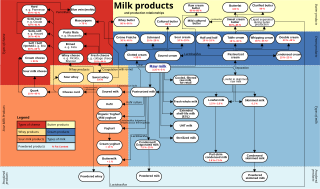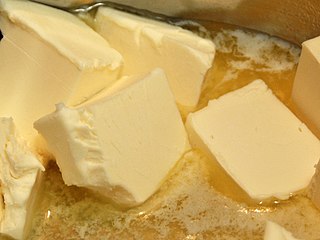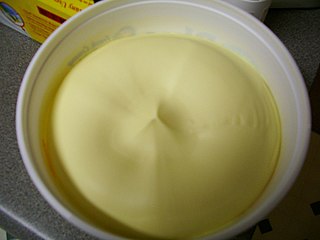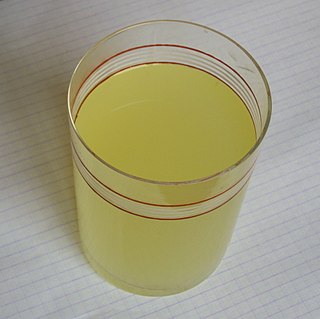
Cream is a dairy product composed of the higher-fat layer skimmed from the top of milk before homogenization. In un-homogenized milk, the fat, which is less dense, eventually rises to the top. In the industrial production of cream, this process is accelerated by using centrifuges called "separators". In many countries, it is sold in several grades depending on the total butterfat content. It can be dried to a powder for shipment to distant markets, and contains high levels of saturated fat.

Dairy products or milk products, also known as lacticinia, are food products made from milk. The most common dairy animals are cow, water buffalo, nanny goat, and ewe. Dairy products include common grocery store food around the world such as yogurt, cheese, milk and butter. A facility that produces dairy products is known as a dairy. Dairy products are consumed worldwide to varying degrees. Some people avoid some or all dairy products because of lactose intolerance, veganism, or other health reasons or beliefs.

In nutrition, biology, and chemistry, fat usually means any ester of fatty acids, or a mixture of such compounds, most commonly those that occur in living beings or in food.

Butter is a dairy product made from the fat and protein components of churned cream. It is a semi-solid emulsion at room temperature, consisting of approximately 80% butterfat. It is used at room temperature as a spread, melted as a condiment, and used as a fat in baking, sauce-making, pan frying, and other cooking procedures.

Dietary fiber or roughage is the portion of plant-derived food that cannot be completely broken down by human digestive enzymes. Dietary fibers are diverse in chemical composition, and can be grouped generally by their solubility, viscosity, and fermentability, which affect how fibers are processed in the body. Dietary fiber has two main components: soluble fiber and insoluble fiber, which are components of plant-based foods, such as legumes, whole grains and cereals, vegetables, fruits, and nuts or seeds. A diet high in regular fiber consumption is generally associated with supporting health and lowering the risk of several diseases. Dietary fiber consists of non-starch polysaccharides and other plant components such as cellulose, resistant starch, resistant dextrins, inulin, lignins, chitins, pectins, beta-glucans, and oligosaccharides.

Margarine is a spread used for flavoring, baking, and cooking. It is most often used as a substitute for butter. Although originally made from animal fats, most margarine consumed today is made from vegetable oil. The spread was originally named oleomargarine from Latin for oleum and Greek margarite. The name was later shortened to margarine.

A food pyramid is a representation of the optimal number of servings to be eaten each day from each of the basic food groups. The first pyramid was published in Sweden in 1974. The 1992 pyramid introduced by the United States Department of Agriculture (USDA) was called the "Food Guide Pyramid" or "Eating Right Pyramid". It was updated in 2005 to "MyPyramid", and then it was replaced by "MyPlate" in 2011.

Whey is the liquid remaining after milk has been curdled and strained. It is a byproduct of the manufacturing of cheese or casein and has several commercial uses. Sweet whey is a byproduct resulting from the manufacture of rennet types of hard cheese, like cheddar or Swiss cheese. Acid whey is a byproduct brought out during the making of acid types of dairy products, such as strained yogurt.

Buttermilk is a fermented dairy drink. Traditionally, it was the liquid left behind after churning butter out of cultured cream. As most modern butter in western countries is not made with cultured cream but uncultured sweet cream, most modern buttermilk in western countries is cultured separately. It is common in warm climates where unrefrigerated milk sours quickly.
A saturated fat is a type of fat in which the fatty acid chains have all single bonds. A fat known as a glyceride is made of two kinds of smaller molecules: a short glycerol backbone and fatty acids that each contain a long linear or branched chain of carbon (C) atoms. Along the chain, some carbon atoms are linked by single bonds (-C-C-) and others are linked by double bonds (-C=C-). A double bond along the carbon chain can react with a pair of hydrogen atoms to change into a single -C-C- bond, with each H atom now bonded to one of the two C atoms. Glyceride fats without any carbon chain double bonds are called saturated because they are "saturated with" hydrogen atoms, having no double bonds available to react with more hydrogen.

Stearic acid is a saturated fatty acid with an 18-carbon chain. The IUPAC name is octadecanoic acid. It is a soft waxy solid with the formula CH3(CH2)16CO2H. The triglyceride derived from three molecules of stearic acid is called stearin. Stearic acid is a prevalent fatty-acid in nature, found in many animal and vegetable fats, but is usually higher in animal fat than vegetable fat. It has a melting point of 69.4 °C and a pKa of 4.50.

Ice milk, or iced milk, is a frozen dessert made with frozen dairy milk, but with less milk fat than regular ice cream. Ice milk is sometimes priced lower than ice cream.

Palmitic acid is a fatty acid with a 16-carbon chain. It is the most common saturated fatty acid found in animals, plants and microorganisms. Its chemical formula is CH3(CH2)14COOH, and its C:D is 16:0. It is a major component of the oil from the fruit of oil palms, making up to 44% of total fats. Meats, cheeses, butter, and other dairy products also contain palmitic acid, amounting to 50–60% of total fats. Palmitates are the salts and esters of palmitic acid. The palmitate anion is the observed form of palmitic acid at physiologic pH (7.4). Major sources of C16:0 are palm oil, palm kernel oil, coconut oil, and milk fat.
In biochemistry and nutrition, a monounsaturated fat is a fat that contains a monounsaturated fatty acid (MUFA), a subclass of fatty acid characterized by having a double bond in the fatty acid chain with all of the remaining carbon atoms being single-bonded. By contrast, polyunsaturated fatty acids (PUFAs) have more than one double bond.

Goat milk is the milk of domestic goats. Goats produce about 2% of the world's total annual milk supply. Some goats are bred specifically for milk. Goat milk naturally has small, well-emulsified fat globules, which means the cream will stay in suspension for a longer period of time than cow's milk; therefore, it does not need to be homogenized. Eventually, the cream will rise to the top over a period of a few days. If the milk is to be used to make cheese, homogenization is not recommended, as this changes the structure of the milk, affecting the culture's ability to coagulate the milk and the final quality and yield of cheese.

Medium-chain triglycerides (MCTs) are triglycerides with two or three fatty acids having an aliphatic tail of 6–12 carbon atoms, i.e. medium-chain fatty acids (MCFAs). Rich food sources for commercial extraction of MCTs include palm kernel oil and coconut oil.
Vaccenic acid is a naturally occurring trans fatty acid and an omega-7 fatty acid. It is the predominant kind of trans-fatty acid found in human milk, in the fat of ruminants, and in dairy products such as milk, butter, and yogurt. Trans fat in human milk may depend on trans fat content in food.
Omega-7 fatty acids are a class of unsaturated fatty acids in which the site of unsaturation is seven carbon atoms from the end of the carbon chain. The two most common omega-7 fatty acids in nature are palmitoleic acid and vaccenic acid. They are widely used in cosmetics due to their moisturizing properties. Omega-7 fats are not essential fatty acids in humans as they can be made endogenously. Diets rich in omega-7 fatty acids have been shown to have beneficial health effects, such as increasing levels of HDL cholesterol and lowering levels of LDL cholesterol.

A Babcock bottle is a clear glass flask with a long graduated neck, used in the Babcock test to evaluate the cream contents of milk. It is also called a Babcock milk test bottle, milk test bottle, cream test bottle, and other similar names.

Trans fat, also called trans-unsaturated fatty acids, or trans fatty acids, is a type of unsaturated fat that occurs in foods. Trace concentrations of trans fats occur naturally, but large amounts are found in some processed foods. Since consumption of trans fats is unhealthy, artificial trans fats are highly regulated or banned in many nations. However, they are still widely consumed in developing nations, resulting in hundreds of thousands of deaths each year. The World Health Organization (WHO) has set a goal to make the world free from industrially produced trans fat by the end of 2023.

















